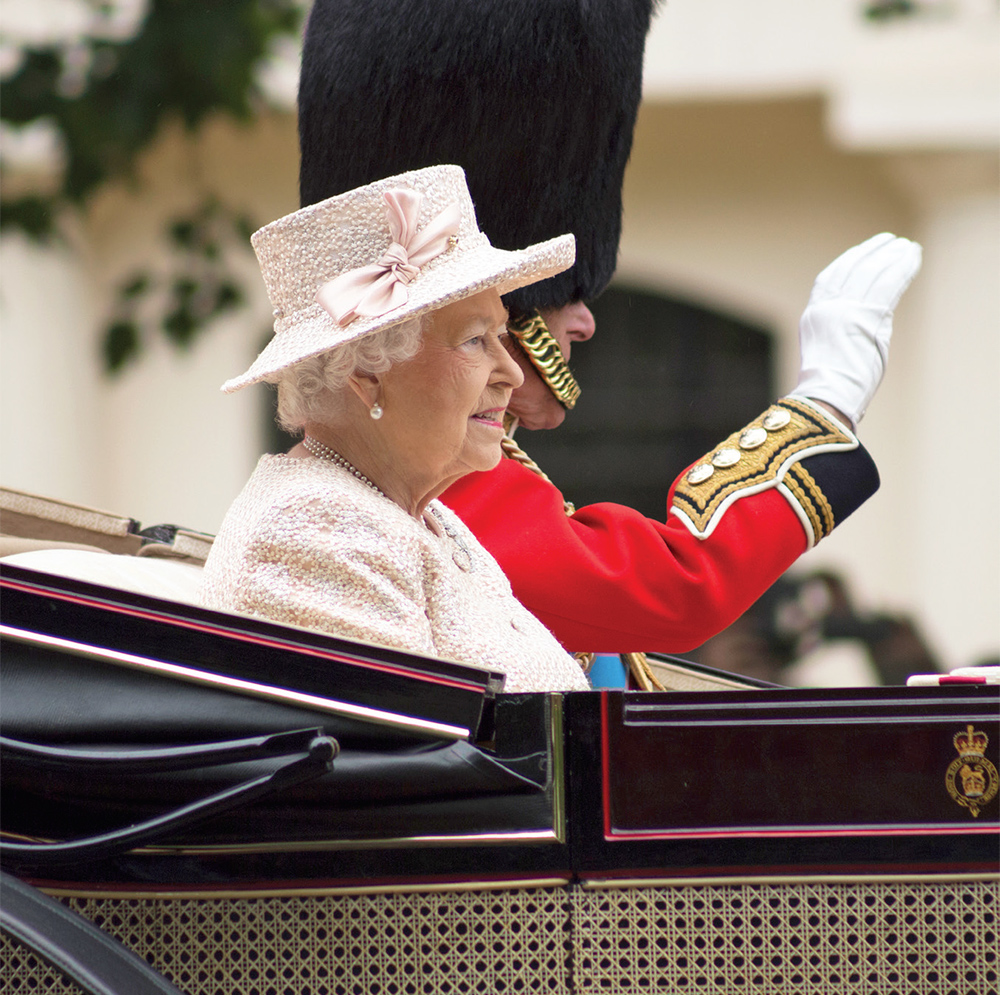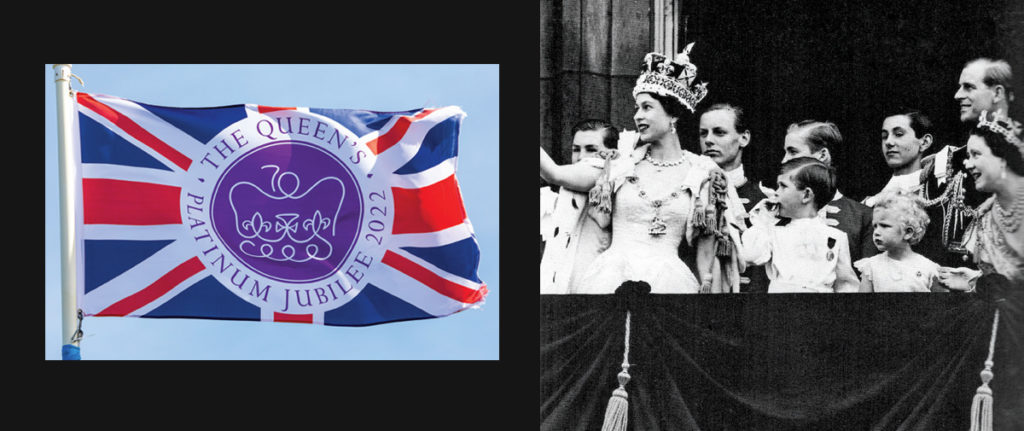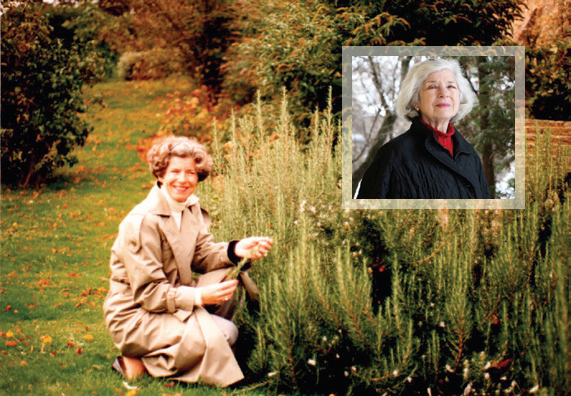

I was first moved to write about my childhood memories of Queen Elizabeth following the celebrations for her Platinum Jubilee, a milestone event for her 70 years as Monarch in British sovereignty and history. It was clear that the Queen became frailer after the loss of Prince Philip, but her death on September 8, 2022, at age 96, coming after the smiling photographs of her two days earlier with her new Prime Minister, was a shock.
The Second World War was coming to an end. Victory in Europe was declared on May 8, 1945. King George VI and Queen Elizabeth, together with their daughters Elizabeth and Margaret and with Winston Churchill, shared the nation’s euphoria from the balcony at Buckingham Palace as multitudes sang the National Anthem and wartime favorites. The King and Queen had helped to sustain a nation that “kept calm and carried on.”
They had walked through bombed out areas, often when the rubble was still smoldering, comforting people in shock, people with virtually nothing left. They were greeted with tears and cheers. Churchill, too, walked through the hardest hit areas. “Good Old Winnie” they said, “we knew you’d come.”
Princesses Elizabeth and Margaret emerged from their wartime home at Windsor Castle. There, Princess Elizabeth began her apprenticeship to become a reigning queen. Her father introduced her to the constitutional duties of the monarch, including “doing the boxes”. The red dispatch boxes, containing vital government documents to be reviewed and signed by the sovereign, are delivered every day except Sundays and Christmas Day. Out of the public eye a dutiful monarch has a desk job for the rest of their life.
She corresponded too with a handsome, exiled Prince of Greece, Philip, who had graduated the Royal Naval College at Dartmouth, and was serving with distinction in the Royal Navy. The princess was 13 and he 18 at their first publicly recorded meeting, in 1939, when the royal family visited the Royal Naval College. He a showoff then, she impressed, they would share a love that would last a lifetime.


In 1945, my family moved from near London to the bracing air of the Kent Coast. Barbed wire and fortifications were still in place along the coastline. I wasn’t told that my father was seriously ill. He was always cheerful and joking, a blithe spirit.
On November 20, 1947, sitting in the kitchen with its big farmhouse table and Aga stove, we listened to BBC broadcast the marriage service of Princess Elizabeth and the now British citizen Lieutenant Philip Mountbatten from Westminster Abbey. Her young voice came clearly through to radio listeners as she took her vows. The announcement of their engagement in the summer was joyous news in a war-scarred country, experiencing rationing and shortages everywhere.
Cheered by thousands of people on the route from the Abbey, they appeared on the Buckingham Palace Balcony. BBC Radio, newspapers, and newsreels recorded it all in black and white. My Christmas and birthday presents were usually books, including the commemorative books about the royal family. They captured my imagination. I still have some of them.
Their wedding presents were exhibited, together with the princess’s wedding dress, at St. James’ Palace. I went with my parents and saved the catalogue. Incredible jewels from royalty, useful household gifts, and items handmade using precious clothing coupons came from people all over the country.
After their honeymoon at Broadlands in Hampshire, the residence of Philip’s uncle, Earl Mountbatten of Burma, Philip continued to serve in the Royal Navy, stationed in Malta. The princess joined him there as a Navy wife. It was perhaps the most “normal” period of her life.
My father died in June 1948, and we moved to Bournemouth in Hampshire.
On November 14, 1948, the BBC announced that “Princess Elizabeth had been safely delivered of a boy” and the newsboys cried, “Princess has a boy! Read all about it, read all about it.” The future King Charles was born. Two years later, on August 15, I remember hearing the announcement of Princess Anne’s birth.
Many young girls then started ballet lessons, inspired by the great ballerina Margot Fonteyn. I was among them. She was one of the most admired people in Britain. I auditioned for, and was accepted at, The Legat School of Ballet in Tunbridge Wells, Kent. The principal was Madame Nadine Nicolaeva-Legat a former Russian ballerina, who had fled The Revolution.
On February 6, 1952, curious, we were all summoned to the practice studio. The tiny Russian woman, with the careworn face, and pronounced limp, spoke with her still strong accent: “Children, ze king is dead! Long live ze queen! Come, ve sing ze National Anthem.” And she sat at the old upright piano that she played for ballet classes, (I don’t think it had ever been tuned) and spontaneously banged out “God Save the Queen.”
Six days before, the 25-year-old princess and Prince Philip started a long tour of the Commonwealth instead of her parents. The king had undergone surgery for lung cancer and was too ill to go, but he, the Queen and Princess Margaret were at London Airport to wish his daughter and son-in-law “Godspeed.” It was a bitterly cold and windy day, and he stood hatless, watching the BOAC plane taxi away.

Elizabeth and Philip were at Treetops Hotel in Kenya, when Philip gave the news to his wife that the king had died in his sleep at Sandringham. A somber return to London followed; among those meeting the new queen at London Airport, was her first Prime Minister, Winston Churchill. He, distraught that the king he served so faithfully in wartime was gone, and his new Sovereign was as he said, “just a child.”
The nation mourned, but unlike the world-wide experience of this past September, the prevailing coverage was from BBC Radio, newspapers, and newsreels. Rites for a monarch’s funeral, those of the Church of England with traditions from the time of Queen Victoria, would not be repeated until over 70 years later, when few were left to remember those earlier sad days.
On June 2, 1953, friends invited us to watch the coronation on their new television set, bought for the occasion. My mother and I watched television for the first time. It was also the first time that the nation experienced the crowning of its sovereign, in the solemnity and splendor of Westminster Abbey. Prince Philip had been instrumental in the service being televised, much to the dismay of some “Old Guard.”
At home, we toasted the new queen. For several days, multitudes had staked out places along the route between Buckingham Palace and the Abbey. Highlighted with the queen and Prince Philip in the gold state coach, the color and pageantry of the procession overwhelmed the senses to celebrate this new Elizabethan Age. Finally, the war was behind us. Ration books were consigned to the “dust bin” or like mine, saved as a souvenir.
My determination (obstinacy) to follow a ballet career took me away from England. But then injury, choice, and twists of fate, brought me to the United States. It became my home. Like so many Americans, I followed Royal milestones. The marriage of Prince Charles and Princess Diana was televised world-wide, and we stayed up half the night, disbelieving, as the news came from Paris of Princess Diana’s death. I still added Royal books to my library. Even, for a while, I had a Pembroke Welsh Corgi.
The decades of the queen’s reign were highlighted by Jubilees, anniversaries, royal marriages, and State occasions, but in between there were thousands of public engagements, over 240 overseas tours, and always, the daily “boxes” delivered from Whitehall even during treasured family holidays. Around 2010, I began reading British newspapers online. I “found” the Royal Family again.
Plans progressed for the Platinum Jubilee, even as Covid kept the queen and Prince Philip isolated in the “HMS Bubble” at Windsor Castle. Prince Philip died in April, 2021 two months short of his 100th birthday. Now the queen faced the milestone of her Jubilee alone.
She always had a sense of humor, and when the screens lit up outside Buckingham Palace for the Platinum Pageant, there sat the queen at a tea table opposite Paddington Bear. “Thank you, Your Majesty, for inviting me.” “Tea?” offered the queen. After a few typical Paddington mishaps with the teapot and the cream cake, “Never mind” said the queen. “Would your Majesty like a marmalade sandwich?” Taking off his red felt hat, “I always keep one in here, just for emergencies.”
Then, as Paddington’s eyes opened wide, the queen said, “I keep mine in here”, she opened her handbag and took out a wrapped sandwich, “Mine is for later” she said. She closed the handbag. There had always been speculation about what she kept in it. Now she was telling us, thanks to Paddington. It was a marmalade sandwich; she was having the last laugh with us.
I must confess it was my introduction to Paddington Bear. With his creator, he has several Wikipedia pages. Three months later, amid the grandeur, tributes, and world-wide sense of loss, Paddington was everywhere, most notably in the poignant painting of artist Eleanor Tomlinson. The queen holds his hand, with a Corgi on the other side of her, walking home.
When the queen left Australia for the last time in 2011, she spoke some words of the First Peoples:
“We are all visitors to this time and place. We are just passing through to learn, to grow, to love and then to return home,”
Elizabeth the Queen has passed through her life with devotion to duty, love of family, and country, and now she has returned home.
Barbara Benson was 9 when she listened to the marriage of Princess Elizabeth and Prince Philip on the radio in 1947. She was a child of the war and recalls the Battle of Britain and the night bombings and rockets that landed near her hometown of Bromley. There were nights her family was ordered to leave home and enter bomb shelters. In the photo above, Barbara Benson returns to the Chartwell, Churchill’s Home, with her husband Larry (1989). She grew up in England and then first visited New York City in 1959. Making America her home, she would proudly become a citizen. Since moving to Barrington in 1980, Benson has been area historian, writer, and participant in civic activities.

Share this Story